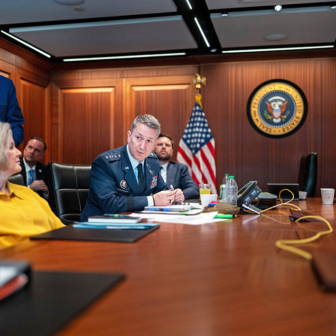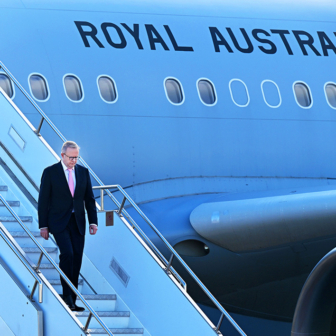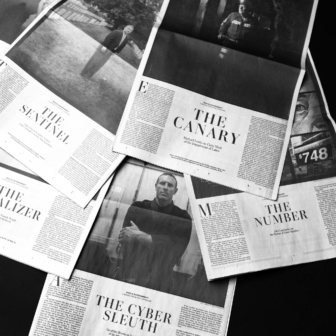Barack Obama is on the phone in the Oval Office. The photograph shows him standing by his desk, one foot on the arm of a red leather chair, the receiver trapped against his shoulder so he can gesture with both hands. Somehow he and the desk don’t seem to belong together. It’s a massive, ornately carved structure resembling a mausoleum, and the images we see in the Brook Lapping documentary Obama: Eight Years in Power (SBS) show the president as a lean, agile figure who rarely sits at it.
This is the symbolically named Resolute desk, built by Queen Victoria’s craftsmen from the timbers of HMS Resolute, a British naval vessel rescued by an American whaler after it became icebound and was abandoned by its not entirely resolute crew. The desk’s hefty presence expresses another order of resoluteness, one that allowed the helmsmen of the new world to pilot a course that left the old world in its wake. Abraham Lincoln, whose portrait is visible in the background of the photograph, never got to sit at it. It arrived after his time. Yet between these two presidents stretches an arc of history that is also an extraordinary story of human resolve.
The Lincoln end of it was told by Ken Burns in his landmark series The Civil War, made for PBS in 1990. Burns pioneered the documentary as a form of narrative television, and built his story around photographs and descriptive accounts rather than scenic footage. For Obama: Eight Years in Power (originally and more appropriately titled Inside Obama’s White House by the BBC), producer Norma Percy had to reckon with the fact that you can’t take a video camera into meetings in the Oval Office or any of the other rooms in the West Wing, where the heavy doors are closed while the leading players in American politics thrash out impossible dilemmas. But the still photograph has other ways of telling us what is going on. It is so much more effective at capturing subtext through body language, facial expressions and the disposition of people around a room. Like the dilemma in which these figures are caught, the photograph freezes time, revealing the critical instant as an impasse that must seem, for those involved, to go on forever.
It is all about the fierce urgency of now, as Obama declared in his most upbeat campaign speeches. Though when the fired-up orator on the podium spoke those words (echoed from Martin Luther King) he would not have envisaged just how deeply the now moment can bite when the time comes to make decisions in which the fate of nations is at stake. The still images show us those moments, but it’s the interviews in this documentary that convey the dramatic edge, tracking how situations arise, how odds are stacked, where the options lie, and what is at stake.
When it comes to strategies for gaining insider access, the production house of Brook Lapping is second to none. Its previous work includes The Rise and Fall of Tony Blair (2007), The Hunt for Bin Laden (2012) and The Iraq War (2013). Here it gives us the full cast of the West Wing, including House of Representatives leader Nancy Pelosi, chief of staff Rahm Emanuel, attorney-general Eric Holder, defense secretary Leon Panetta and campaign strategist David Axelrod, as well as members of Congress from both sides of politics.
The commentator-in-chief, though, is Obama himself. Just forty minutes of interview time, distributed expertly throughout the four hours of broadcast time, is sufficient to get an incisive view of all the major issues covered. When it comes to “issues,” every US president must expect to encounter the biggest of them. Obama’s encounters began with the global financial crisis and the urgent need to pass a massive bailout package, then moved through the stalled attempts to close Guantanamo, the bitterly divisive process of trying to get healthcare reform through Congress, a rolling set of crises in the Middle East, and a re-election campaign. “Most of the decisions I make,” he says at one point, “don’t lend themselves to a clean, crisp, wonderful solution. When they do, somebody else typically solves them and they never arrive at my desk.”
As we see across the four parts of the documentary, most of the decisions he makes invite comparison with “Sully” landing US Airways Flight 1549 on the Hudson River. It’s a fraught, messy, dangerous business. Seriously dangerous. Lives and livelihoods, many of them, are at stake every time. Yet, however ungainly the landing, the plane doesn’t break up and those on board get to see another day. Finely honed skills are involved in executing the manoeuvre. But it’s a group effort, as Chesley Sullenberger has insisted and as participants in those exhausting summit meetings in Obama’s White House testify, though a certain grit or resolve on the part of the pilot can make the difference between survival and disaster.
There’s a mystique about a resoluteness operating at this level. It keeps someone working eighteen-hour days, maintaining a level head through a rolling sequence of chaotic events, and yet able to make the single available constructive decision in the face of what looks like a disastrous endgame. Perhaps that’s something more than resoluteness, and might be better called stoicism. Obama, like Lincoln, is a natural stoic. Whether either of them would have retired for the night with a copy of Seneca’s letters is not the point. Stoicism didn’t begin as a doctrine, but as a model for human behaviour and a technique for managing the mind under conditions of extreme stress. Watching a true stoic find the path through a morass of potentially fatal consequences is as gripping as the denouement of any thriller.
With no blueprint for the role, life in the Oval Office is a roller-coaster. Kennedy had to steer through the Bay of Pigs crisis, Nixon lived with the Watergate debacle, Clinton was hounded to the point of impeachment, George Bush had to respond to the events of 9/11. Lincoln, perhaps the most beset of all of them, had a civil war on his hands. These situations are so vastly different that each presidency is defined anew, through a strange alchemy between the office and its occupant. Parallels and ironies occur, nevertheless.
The trailer for Spielberg’s film Lincoln includes a clip from a scene in which Daniel Day-Lewis, that virtuoso of husky intonations and broken cadences, stands to confront his advisers. “I am the president of the United States of America,” he pronounces, “clothed in immense power. You will procure me these votes.” That voice rang in my head as, in the opening minutes of the documentary, someone described Obama leaving a meeting with the declaration, “I am president of the United States and I can’t make anything happen.”
As I rewatched the scene from Lincoln, the ironies shifted, and the parallels strengthened. Lincoln’s pronouncement comes across as a piece of theatrics, a magnificent bluff to sweep away the defeatism that has taken a stranglehold on his advisers around the table. The speech actually begins in what sounds like his own expression of defeat. “I can’t accomplish a goddam thing of any human meaning or worth until we cure ourselves of slavery and end this pestilential war.” It ends with that ultimatum to procure the votes. He’s two short of the target, just as Obama was with his healthcare bill, and Obama charged his whips and strategists with getting them, just as fiercely as Lincoln did. There’s the same sense of vast possibilities turning on the minutiae of negotiation: on “picking that lock,” as one of the Obama team puts it.
A century before Martin Luther King coined that phrase, “the fierce urgency of now,” Lincoln was possessed with a sense that he had been gifted the now moment, placed at a turning point in history where a burning consciousness of immediacy was the key to the future. For Lincoln, that future was the United States itself, and his overriding resolve was to make it happen. Obama brought a vision for a reunited America, and in episode one we see him delivering the quintessential campaign speech. “If we could just recognise ourselves in one another and bring everyone together – Democrats, Republicans and Independents, Latino, Asian, Black, White, Native American… If we see each other in each other’s eyes and bring those walls tumbling down. That is our hope.”
For all his stoic mastery of realpolitik, though, this vision of union was Obama’s Achilles heel. What he had failed to confront was the psychological reality of dealing with an opposition for whom his own brilliance was an offence. The higher he rode in popularity, style and flair, the more the Republicans were made to feel that, as party pollster Frank Luntz puts it, they “simply didn’t matter.” Realpolitik in the contemporary political world means more than the art of strategic compromise. It means facing up to the fact that hysteria can defeat reason and vindictiveness may be a more powerful force in the electorate than any liking for what may serve the public good.
SBS chose to show the four parts of Obama: Eight Years in Power in two double episodes, each of which ran to two hours. That’s an endurance test with material of this density and intensity. It’s a superb documentary, edited to create a powerful dramatic composition, and with an assured instinct for tone, helped by the narration of former White House correspondent Frank Sesno. It’s worth watching more than once, and taking your own time over it, while the whole series is available through SBS On Demand. •




